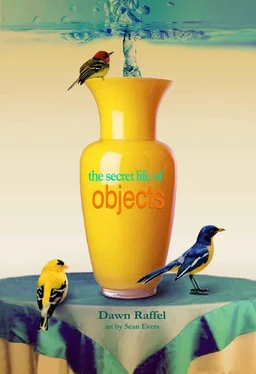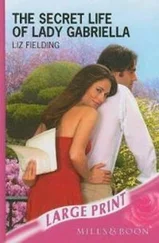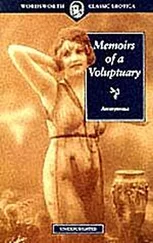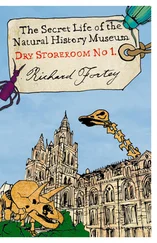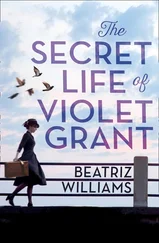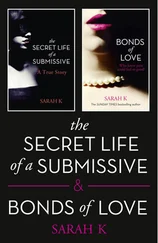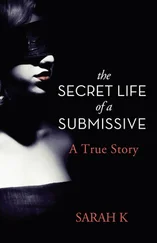Then I saw a simple cotton-blend sheath with cutouts at the neckline and delicate beading in blue and pink and lavender. I’d never seen it on her. I looked at the label, which said FAITH. I added taupe heels, a glass heart necklace from her beloved art museum. She didn’t need a bag but in the eleventh hour my stepfather and I tucked a packet of her ubiquitous Kleenex tissue into the coffin.
I found the Barton’s candy box the next year, after my stepfather died. Amid the orphaned threads, the threaded needles, pins, I saw the extra buttons to the dress, attached to the cardboard price tag that said FAITH.
And so I have two sewing boxes, though I rarely use them. The long-lost puzzle that my grandmother gave me had dialogue under those campy, weepy hearts: “I don’t miss you. I have something in my eye.”
The sleeveless jersey dress is far beyond repair. It’s stained. It doesn’t fit. The fabric has faded. Goodwill would not want it. I keep it in my closet because it holds in its weave the summer of 1984: the heat, my young body, the necklace — all hearts — that I wore with it that broke, our rooftop in twilight, the city below us, the promise of the life I planned to live. That dress was so green.
The couple from the top of the wedding cake is sitting, or rather standing, on top of the dresser, next to the coins and the answering machine, which is blinking again, the jewelry box, the blue glass lamp. They’re poised for rice, or birdseed. The dress is discolored. That dress was so white.
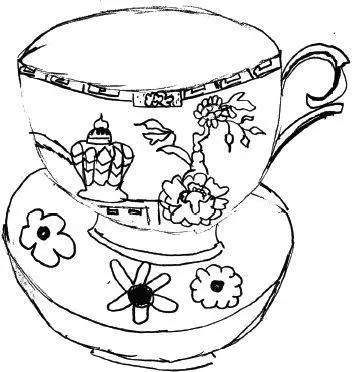
At 20, I went to visit my closest friend from college during her junior year in London. We had been roommates in the Midwest, but she’d gone overseas and I had transferred to an East Coast college where I realized that, yes, there is a class system in America and, yes, I was outclassed. I sensed unspoken rules that I didn’t understand. I had spent my summers waitressing and hostessing at places with names like Mr. Steak and — for one especially demeaning week before I was fired for a lethal combination of incompetence and a reprehensible attitude — serving overpriced chops while wearing a uniform that involved a plastic miniskirt and a holster. My classmates, meanwhile, had apparently spent their summers interning in Senator Kennedy’s office. Imagine my surprise when I discovered that I had an accent. I was eager to escape for Christmas break and equally eager not to go back to Wisconsin where, during those pre-climate change years, the temperature often dipped below minus-20, and where my parents’ post-divorce relations remained somewhat chilly.
Freddy Laker’s airline, with service from New York to London, was as cheap as it got. They didn’t sell tickets in advance (you had to show up and wait), or serve food on board (not even micro-pretzels), and the original seats had been removed so that smaller, cheaper ones could be wedged in. (I weighed 90 pounds dripping wet; I can’t imagine how someone larger must have felt). Everyone smoked. It was like crossing the Atlantic in an ashtray — in my case, next to a woman who wanted to describe to me all the way over the ocean how plants talked to her. I can’t remember what they said.
C met me at Heathrow. She had gone punk. She had also discovered that if you told Londoners that you were an American journalist and, I suppose, at least as importantly, if you were an attractive young woman, you could get backstage at any concert. (“We’re going to hear the Boomtown Rats and after that there’s an all-night party,” she announced at the airport, but an hour later when I fell down half a flight of stairs due to jetlag, I decided I’d better sit that one out). To earn money, C worked at a pub where her fellow beer puller, Mrs. Lydon, was Johnny Rotten’s mother.
The reality, though, is that we were Midwestern girls gorging on our temporary freedom, much the way my grandfather indulged at a buffet. While punk and rage called us, so did high tea and crumpets, clotted cream and white gloves. Conventional wisdom has it that at 20 you don’t know who you are, but I think I understood, at the very least, who I wasn’t, and that I had better visit while I could the worlds — punk, high tea — to which I would never belong. I understood, as well, the world I didn’t want to live in: my mother’s. For all that I didn’t fit in at an East Coast school, I didn’t fit either in the Wisconsin of the 1960s and 1970s — too bookish, too dark-haired, too oddly dressed, too slow to smile. It wasn’t until I first laid eyes on Greenwich Village, six months after London, that I recognized, for the first time, a place where I belonged. In a neighborhood where everyone appeared to be a misfit, I could fit right in.
The teacup was a gift from C to me. She bought it at Harrod’s: a single, expensive, floral china cup with a saucer to match. That I have never drunk from it, and that I still have it, and that C is my closest friend 31 years later, says something, I think, about a woman’s education, or maybe only us.
I met L in London when I went to visit C. She was a theater major who ended up dropping out of school to go to New York and act. Right after graduation, C and I moved to New York too, with the idea that we would both get glamorous jobs as assistants at magazines. That this plan worked (although the glamour part amounted to accepting invitations, palmed off on us by our bosses, to luncheons at Tavern on the Green and 21, where in return for a chicken cutlet we were required to sit through mind-blowingly boring pitches for products the magazine was never going to feature; we also occasionally rubbed elbows with well-known authors who were slumming by writing for “the glossies”—one sent C, in the envelope with his typewritten manuscript, an invoice for the stamp) — that we quickly found jobs as well as an apartment was a tribute both to the times and to the dumb luck of the naïve. We lived in the heart of the Village, and everyone we knew was a writer or an actor or an artist with a day job. We saw L all the time.
In 1979, New York was dirty and dangerous. (I used to contend that my mother believed the Certain Death Zone was anything beyond the nine-block stretch between the Plaza Hotel and Saks, although she loved the Village Halloween parade—“Wait! Is that a man or a woman?” I couldn’t get her to leave, despite the freezing weather; the only ones wearing dresses that day were men.) You could live in the Village on next to nothing (which was what C and I earned) as long as you didn’t mind walking up seven flights, or having your bathtub in the kitchen, or hearing your upstairs neighbors play their Hammond organ at three in the morning, or your downstairs neighbors party and brawl, or someone dropping weights on the floor next door, or, for that matter, sneezing, and as long as you weren’t overly perturbed by roaches and mice in the kitchen, and junkies, trannies, and hookers in the street. (An actor friend of my future husband lived on Avenue D; one night we went back to his place to find a dead mouse splayed out on the floor next to a scrap of paper. We speculated that the neighborhood was so bad that even the mice were committing suicide.) You could nurse one cheap cup of coffee at the Figaro all night (we used to have contests to see who could sit in the café longest without ordering anything — the winning time was 42 minutes — or fill up on kasha varnishkas at the Veselka, or the dense vegetable soup and challah at the Kiev where the elderly Ukrainians coexisted nonchalantly with kids with green hair and safety pins through their noses, or go dancing at the Ritz, where you might get in free wearing a miniskirt and, if not, there was always some Wall Street guy happy to pick up the tab for you and six of your closest friends, or listen to music at Max’s Kansas City, where there was always the possibility that someone might vomit on you, or catch a revival movie at the Bleecker Street Theater, where the projector broke at least once during every showing and the floor stuck to your feet, or take in an offoff-off Broadway show or showcase — L acted in a lot of those. We heard Spalding Gray perform in The Garage in Soho (L said, “You’ve got to hear this guy”) and a teenage Whitney Houston sing with her mother at the Bottom Line. Often we’d end up eating pneumatic muffins at four or five in the morning at the Triumph on Bleecker — we were young enough to do that and still get up a few hours later, and go to work.
Читать дальше
